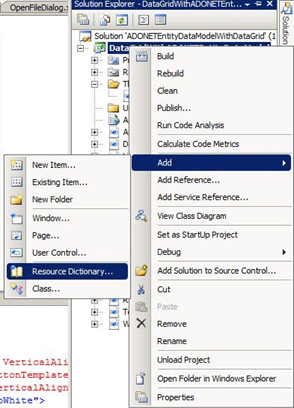ResourceDictionary in WPF
The items in a ResourceDictionary are not immediately processed when application code is loaded by a XAML loader. Instead, the ResourceDictionary persists as an object, and the individual values are processed only when they are specifically requested.
The ResourceDictionary class is not derived from DictionaryBase. Instead, the ResourceDictionary class implements IDictionary but relies on a Hashtable internally.
In Extensible Application Markup Language (XAML), the ResourceDictionary class is typically an implicit collection element that is the object element value of several Resources properties, when given in property element syntax. For details on implicit collections in XAML, see XAML Syntax Terminology. An exception is when you want to specify a merged dictionary; for details, see Merged Resource Dictionaries.
Another possible XAML usage is to declare a resource dictionary as a discrete XAML file, and either load it at run time with Load or include it in a (full-trust) project as a resource or loose file. In this case, ResourceDictionary can be declared as an object element, serving as the root element of the XAML. You must map the appropriate XML namespace values (default for the WPF namespace and typically x: for the XAML namespace) onto the Resource Dictionary element if you plan to use it as the root element. Then you can add child elements that define the resources, each with an x:Key value.
Getting Started:
First of all make a new WPF Application and add a new ResourceDictionary file. I am putting my ResourceDictionary File in Themes directory. Like figure1

Figure1.
Here is my ResourceDictionary file xml code:
See full details: http://www.c-sharpcorner.com/UploadFile/raj1979/176/Default.aspx
The ResourceDictionary class is not derived from DictionaryBase. Instead, the ResourceDictionary class implements IDictionary but relies on a Hashtable internally.
In Extensible Application Markup Language (XAML), the ResourceDictionary class is typically an implicit collection element that is the object element value of several Resources properties, when given in property element syntax. For details on implicit collections in XAML, see XAML Syntax Terminology. An exception is when you want to specify a merged dictionary; for details, see Merged Resource Dictionaries.
Another possible XAML usage is to declare a resource dictionary as a discrete XAML file, and either load it at run time with Load or include it in a (full-trust) project as a resource or loose file. In this case, ResourceDictionary can be declared as an object element, serving as the root element of the XAML. You must map the appropriate XML namespace values (default for the WPF namespace and typically x: for the XAML namespace) onto the Resource Dictionary element if you plan to use it as the root element. Then you can add child elements that define the resources, each with an x:Key value.
Getting Started:
First of all make a new WPF Application and add a new ResourceDictionary file. I am putting my ResourceDictionary File in Themes directory. Like figure1

Figure1.
Here is my ResourceDictionary file xml code:
See full details: http://www.c-sharpcorner.com/UploadFile/raj1979/176/Default.aspx

Comments